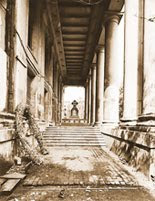When a painterly eye combines with the quill or pen, the outcome is quite striking, particularly in the narration of memoirs. Interestingly, though Indians started writing about their lives by the second half of the 19th century, hardly any appeared to be familiar with the paintbrush or pencil; at best, as a mandatory acceptance of the new visual medium of photography, a studio portrait of the author might appear as the frontispiece. On the other hand, to explore the Indian countryside and its growing urban areas with a paintbrush or early colour-pencils was not unusual for British civil servants, doctors and engineers; several combined this interest with photography, the latter often a requirement of their jobs. A handful of women — often skilled, amateur watercolourists — has left behind a rich legacy of memories brought alive by visual images. While Charlotte Canning inherited a tradition of combining memory with image from Emily Eden and Fanny Parks, she also embellished her writings with photographs. An accomplished photographer (in some of the handful that survives from the thousands she took), she emphasized composition, backdrop and overall effect.
In A Glimpse of the Burning Plain: Leaves from the Indian Journals of Charlotte Canning, the writer of popular history, Charles Allen, has put together engaging gleanings from the first vicereine of India’s paintings, journals and letters about her life in this country. In 1842, Charlotte Canning had been appointed Lady of the Bedchamber by Queen Victoria, an honour that meant that she had to wait upon the woman who was to become Empress of India. When, by the end of 1855, the Cannings were on their way by sea to India, where Charles was to become governor-general, Charlotte initiated a tradition of regular letter-writing to the queen that was to last for over five years.
Full report here Telegraph

No comments:
Post a Comment